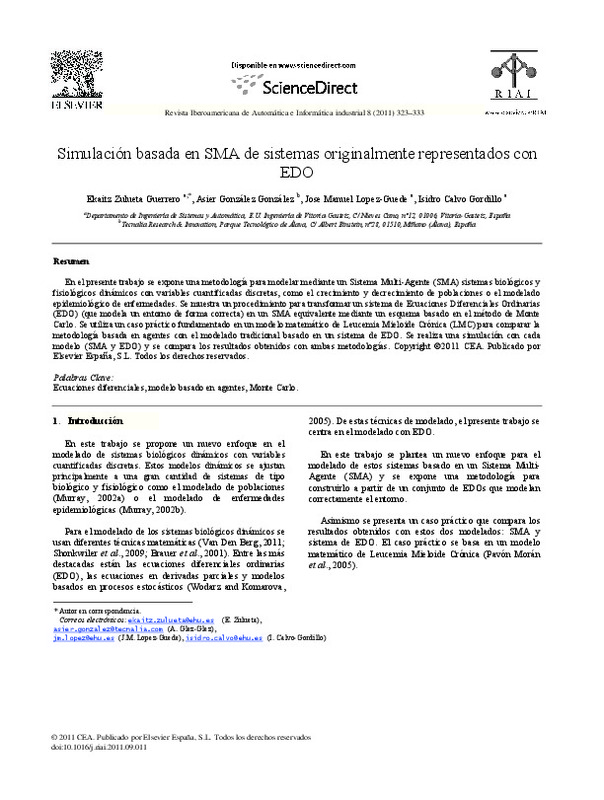Banerjee, S., & Moses, M. E. (2009). A Hybrid Agent Based and Differential Equation Model of Body Size Effects on Pathogen Replication and Immune System Response. Artificial Immune Systems, 14-18. doi:10.1007/978-3-642-03246-2_5
Basse, B., & Ubezio, P. (2007). A Generalised Age- and Phase-Structured Model of Human Tumour Cell Populations Both Unperturbed and Exposed to a Range of Cancer Therapies. Bulletin of Mathematical Biology, 69(5), 1673-1690. doi:10.1007/s11538-006-9185-6
Bunimovich-Mendrazitsky, S., Byrne, H., & Stone, L. (2008). Mathematical Model of Pulsed Immunotherapy for Superficial Bladder Cancer. Bulletin of Mathematical Biology, 70(7), 2055-2076. doi:10.1007/s11538-008-9344-z
[+]
Banerjee, S., & Moses, M. E. (2009). A Hybrid Agent Based and Differential Equation Model of Body Size Effects on Pathogen Replication and Immune System Response. Artificial Immune Systems, 14-18. doi:10.1007/978-3-642-03246-2_5
Basse, B., & Ubezio, P. (2007). A Generalised Age- and Phase-Structured Model of Human Tumour Cell Populations Both Unperturbed and Exposed to a Range of Cancer Therapies. Bulletin of Mathematical Biology, 69(5), 1673-1690. doi:10.1007/s11538-006-9185-6
Bunimovich-Mendrazitsky, S., Byrne, H., & Stone, L. (2008). Mathematical Model of Pulsed Immunotherapy for Superficial Bladder Cancer. Bulletin of Mathematical Biology, 70(7), 2055-2076. doi:10.1007/s11538-008-9344-z
Fianyo, E., Treuil, J.-P., Perrier, E., & Demazeau, Y. (1998). Multi-agent Architecture Integrating Heterogeneous Models of Dynamical Processes: The Representation of Time. Lecture Notes in Computer Science, 226-236. doi:10.1007/10692956_16
Guo, Z., Sloot, P. M. A., & Tay, J. C. (2008). A hybrid agent-based approach for modeling microbiological systems. Journal of Theoretical Biology, 255(2), 163-175. doi:10.1016/j.jtbi.2008.08.008
Lewis, J. T., & Pulè, J. V. (s. f.). Dynamical theories of Brownian motion. Lecture Notes in Physics, 294-296. doi:10.1007/bfb0013344
Moore, H., & Li, N. K. (2004). A mathematical model for chronic myelogenous leukemia (CML) and T cell interaction. Journal of Theoretical Biology, 227(4), 513-523. doi:10.1016/j.jtbi.2003.11.024
Murray J. D., 2002a. Models for Interacting Populations. Mathematical biology. Springer New York, 17, pp. 79-118.
Murray J. D., 2002b. Dynamics of Infectious Diseases: Epidemic Models and AIDS. Mathematical biology, Springer New York, 17, pp. 315-394.
NAGY, J. (2004). Competition and natural selection in a mathematical model of cancer. Bulletin of Mathematical Biology, 66(4), 663-687. doi:10.1016/j.bulm.2003.10.001
Redou, P., Kerdelo, S., Le Gal, C., Querrec, G., Rodin, V., Abgrall, J.-F., & Tisseau, J. (2005). Reaction-Agents: First Mathematical Validation of a Multi-agent System for Dynamical Biochemical Kinetics. Lecture Notes in Computer Science, 156-166. doi:10.1007/11595014_16
Spencer, S. L., Berryman, M. J., García, J. A., & Abbott, D. (2004). An ordinary differential equation model for the multistep transformation to cancer. Journal of Theoretical Biology, 231(4), 515-524. doi:10.1016/j.jtbi.2004.07.006
Szymańska, Z., Urbański, J., & Marciniak-Czochra, A. (2008). Mathematical modelling of the influence of heat shock proteins on cancer invasion of tissue. Journal of Mathematical Biology, 58(4-5), 819-844. doi:10.1007/s00285-008-0220-0
Weyns, D., Van Dyke Parunak, H., Michel, F., Holvoet, T., & Ferber, J. (2005). Environments for Multiagent Systems State-of-the-Art and Research Challenges. Lecture Notes in Computer Science, 1-47. doi:10.1007/978-3-540-32259-7_1
Wu, D., Zhou, J., & Li, Y. (2006). Unbiased estimation of Weibull parameters with the linear regression method. Journal of the European Ceramic Society, 26(7), 1099-1105. doi:10.1016/j.jeurceramsoc.2005.01.044
[-]








